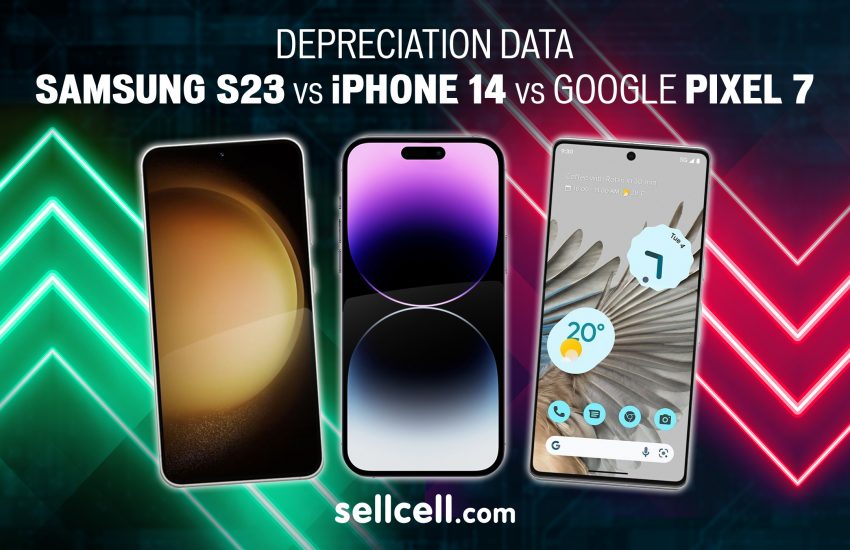Last updated January 17, 2024
…S23 is, however, performing better than the S22 range (2 months post launch) closing the value gap against the iPhone 14. iPhone 14 has also underperformed vs. iPhone 13 in value retention, worth 5.7% less.
SellCell Key Findings
- The Samsung Galaxy S23 depreciates almost one and a half times more (1.4 times) than the iPhone 14 range two months post-launch, losing 43.3% of its value for a handset in “like new” condition.
- The S23 is, however, performing much better than the S22 did in the same time frame, for a like new phone; the S22 had lost three times its value compared to a like new iPhone 13 in the same time frame.
- The iPhone 14 range, in like new condition, is worth 5.7% less than the iPhone 13 range was worth, on average across all models, after six months, with the 14-series depreciating by 31.5%, while the 13-series was at 25.8% in the same timeframe.
- The Google Pixel 7 is the worst performer of the three ranges, losing 45.9% of its value across the range in two months post-launch.
- Google has discounted the Pixel 7 and Pixel 7 Pro by $150 (at the time of writing), which means the value of the smartphone suffers even more for those who paid MSRP at launch.
Purpose of Article
This article will show the latest depreciation data for the Samsung Galaxy S23, the Apple iPhone 14, and the Google Pixel 7 ranges, and compare how the smartphones stack up against each other in terms of value retention.
- Find out how much value the Samsung Galaxy S23 has lost since launch.
- Compare the Galaxy S23 range to the Apple iPhone 14 and Google Pixel 7 ranges in terms of value retention.
- Find out which smartphone holds its value best after launch, compared with the previous generation.
- See how ranges compare, where appropriate at the two-month and six-month points.
- Look at how the iPhone 13 value stacks up vs. iPhone 14.
Let’s see what the data has to say…
Main Findings
- Samsung Galaxy S23 Depreciation is 1.4 times that of iPhone 14. The Samsung Galaxy S23 range loses value on average, at 47.7% (good condition) and 43.3% (like new), with the Pixel 7 range performs worst at 51.1% and 45.9%, and the iPhone 14 range at only 35.0% and 31.0% after 2 months.
- The iPhone 14 range, despite outperforming the Pixel 7 and Galaxy S23, hasn’t performed as well as the iPhone 13 range did within six months post launch. The 14 series has lost, on average, 31.5% of its value in six months, while the 13 series lost 25.8% of its value in the same time period for devices in like new condition.
- The worst performing individual handset is Samsung’s flagship Galaxy S23 Ultra 1TB in good condition, which has lost an eye-watering 55.6% of its value in the two months since launch.
- The Google Pixel 7 range loses the most value on average over the two months post-launch, with a 45.9% loss for a device in like new condition, and a 51.1% loss for a phone in good condition.
- The iPhone 14 Pro Max 128GB, in like new condition, has performed best in the two months post launch, losing only 13.6% of its MSRP.
- Several iPhone 14 models actually regained some of their value; the iPhone 14 Pro Max 128GB, in like new condition, had lost 21.7% after one month, but regained 8.1% of its MSRP to see its value improve in month two with 13.6% of its launch price.
- The best performing Samsung Galaxy model—the S23 Plus 256GB in like new condition—also regained some of its lost value. After one month, it had lost 36.9% of its value, but after two months, depreciation was 36.4%.
- The Pixel 7 Pro 128GB, in like new condition, also clawed back some of its lost value. After one month, depreciation was 43.2%, while after two months, depreciation was 39.4%.
Summary: S23 Depreciation vs. iPhone 14 and Pixel 7

SellCell has analysed internal smartphone value data across the iPhone 14, Galaxy S23, and Pixel 7 ranges for phones in “like new” and “good” condition. The above table illustrates the depreciation of all smartphone models in each respective range, alongside average depreciation across each range, after one and two months post-launch.
Average Depreciation Across Ranges
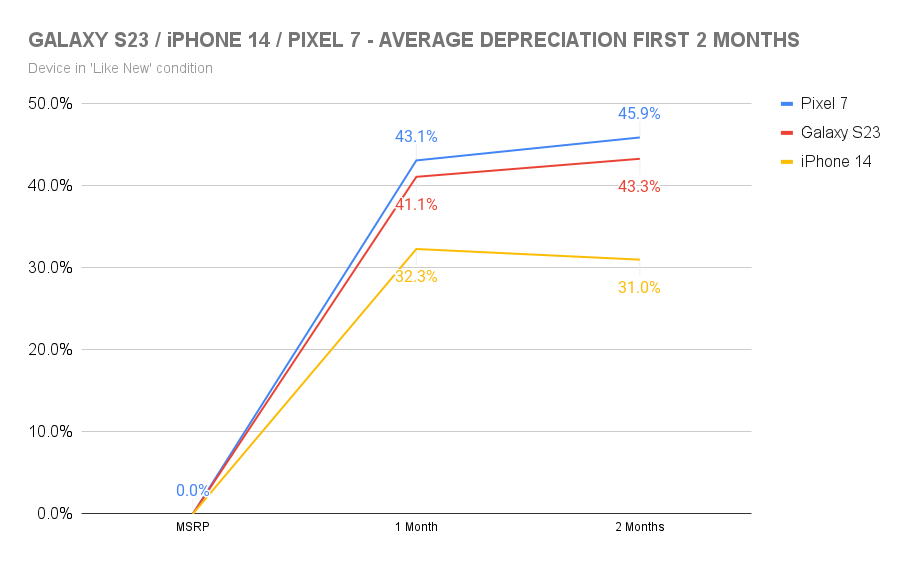

For smartphones in like new condition, we can see from the graph and the data table above that the iPhone 14 series is clearly the best performing range, on average. After one month, it had lost 32.3% of its value. However, after two months, it has regained some of that loss, and depreciation sits at 31.0% on average across all models.
The picture is not quite as rosy for Samsung, though. After one month, S23 depreciation stands at an average of 41.1%, which has increased to 43.3% after two months. This is in contrast to the S22, which saw a plateauing of its value between months one and two in 2022, as shown in last years S22 depreciation report.
Google’s Pixel 7 range is the weakest performer of the three. The series saw on average a 43.1% loss across all models in month one, and after two months this loss was 45.9%. The Pixel 6 managed to regain a little value two months after launch.
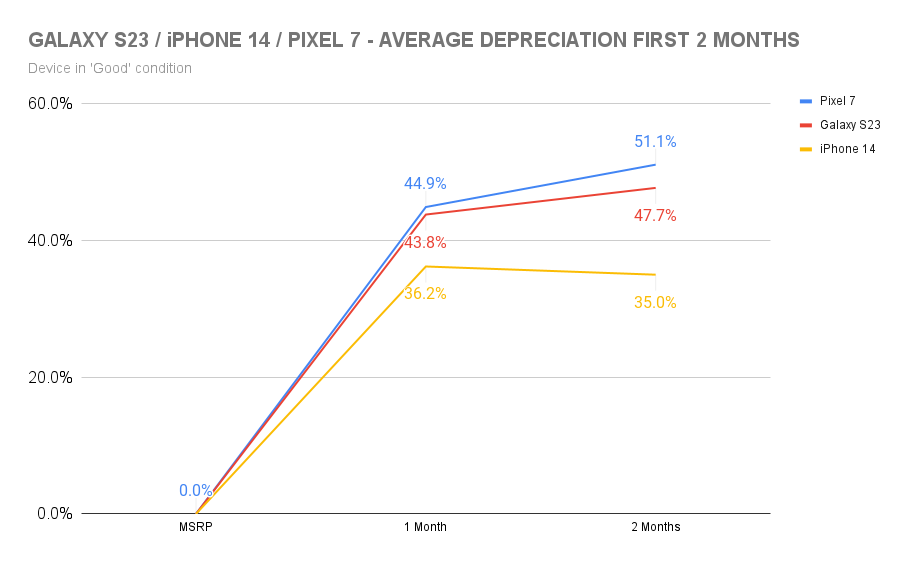

Handsets in good condition present a similar story to those in like new. Again, the iPhone 14 range regains some of its lost value, going from 36.2% in month one to 35.0% after month two on average, across the range.
The Galaxy S23 in good condition drops value by 43.8% in month one to 47.7% by the end of month two. The Pixel 7 is, again, the worst performer, losing value from 44.9% in month one to 51.1% in month two.
Depreciation by Individual Model

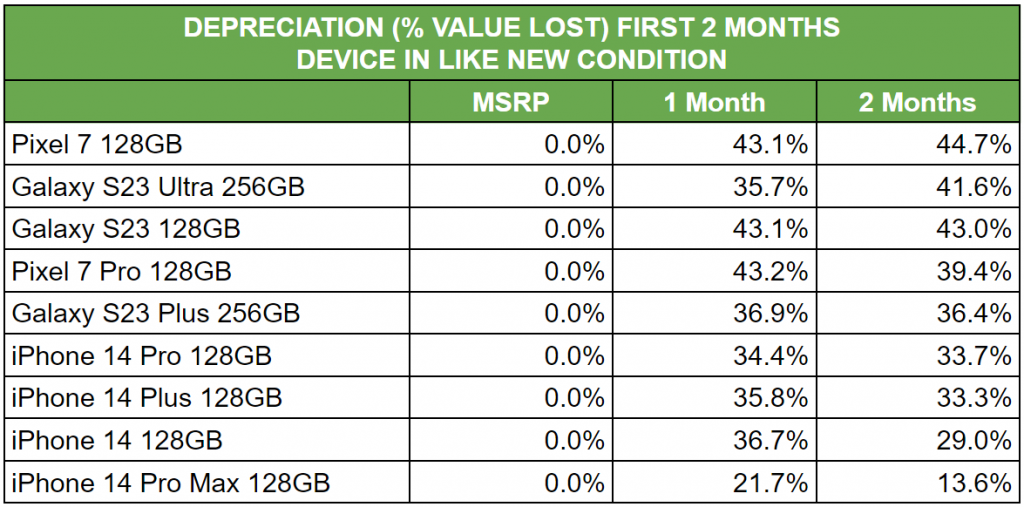
Looking at like new phones model-by-model (using the handsets with the lowest capacity to present a like-for-like case), we can see that things are definitely going well for Apple. The four phones from each series have all regained some of their lost value, with the 14 Pro Max 128GB replenishing 8.1% of its value, going from 21.7% after month one to 13.6% after month two.
We can say the same for two of the Samsung S23 range shown above; the Standard S23 128 GB and the Plus 256 GB versions have both regained a small amount of their value (although nothing like what iPhone 14 has achieved), 0.1% and 0.5% respectively. This could mean that other S23 handsets may see a recuperation of some of that lost value, too, given a little more time. However, the Ultra series doesn’t appear to be favorable, the Ultra 256GB version of the S23 depreciation increasing from 35.7% to 41.6%.
Compared to last year’s figures with the S22, though, the S23 is performing much better. It has only depreciated by 1.4 times more than the iPhone 14; a contrast to the S22’s three times depreciation against the iPhone 13.
As far as Pixel 7 is concerned, the Standard 128GB version has lost 43.1% and 44.7% in months one and two, although the Pro 128GB model has recouped 3.8% of its lost value, going from 43.2% to 39.4%. A mixed bag for Google.
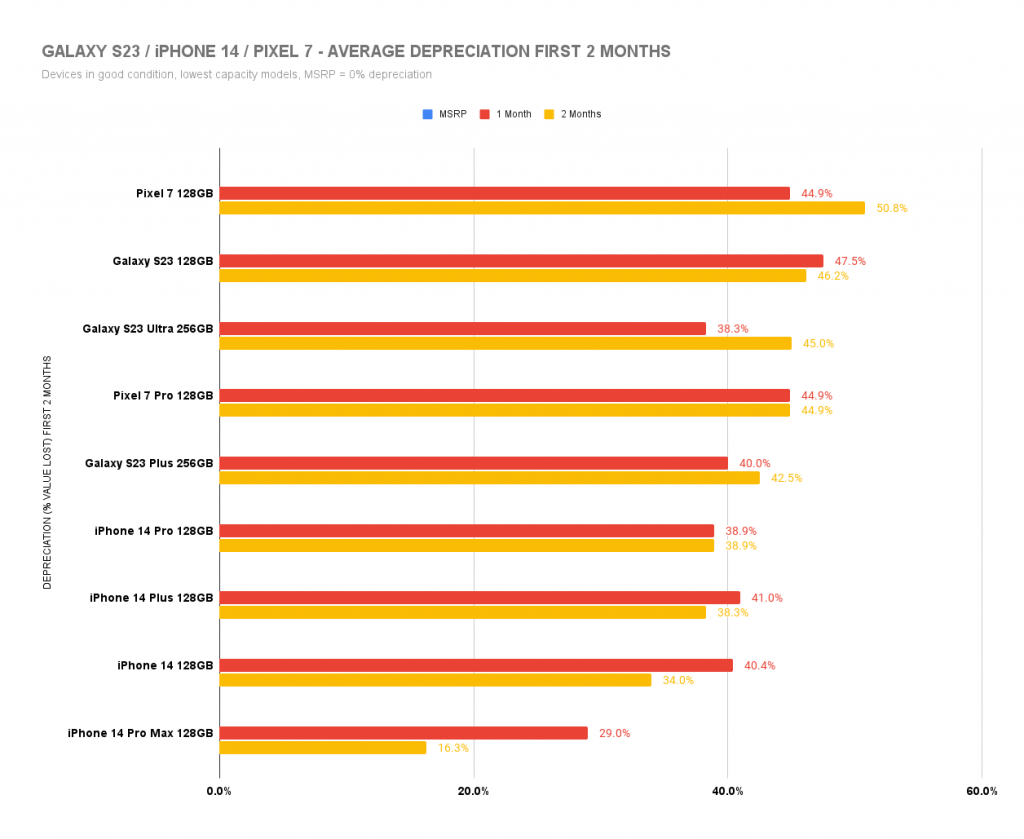

For devices in good condition, we see a very similar story to those in like new condition.
No Pixel 7 models have regained any of their loss, although the Pixel 7 Pro 128GB is staying at 44.9% between the end of month one and the end of month two. The standard Pixel 7 128GB has lost more of its value, however, with its depreciation going from 44.9% to 50.8%.
The standard Galaxy S23 depreciation has shrunk; it has recuperated a small amount of the value it had lost by the end of month one, going from 47.5% to 46.2%. However, the Plus version ended month one at 40.0% depreciation, and has lost a further 2.5% by the end of month two, closing at 42.5% value loss. The Ultra model S23 depreciation has also increased for phones in good condition, jumping from 38.3% to 45.0%.
iPhone 14 has performed well again, with all models but the Pro 128GB regaining some of the initial value loss. The Pro 128GB had plateaued at 38.9% between the ends of month one and two.

It is worth noting, at the time of writing, Google has applied a discount of $150 across the entire range of Pixel 7 and Pixel 7 Pro smartphones. So, if a buyer paid full price for their smartphone at launch, it will be worth even less now, without also taking depreciation into consideration.
iPhone 14 vs. iPhone 13 Depreciation
So, it seems that the iPhone 14 reigns supreme, despite not performing three times better than the Galaxy S23, compared to the iPhone 13 and Galaxy S22 of the previous generation. Putting S23 depreciation to one side, though, lets see how the iPhone 14 fares when compared to the iPhone 13 over six months…
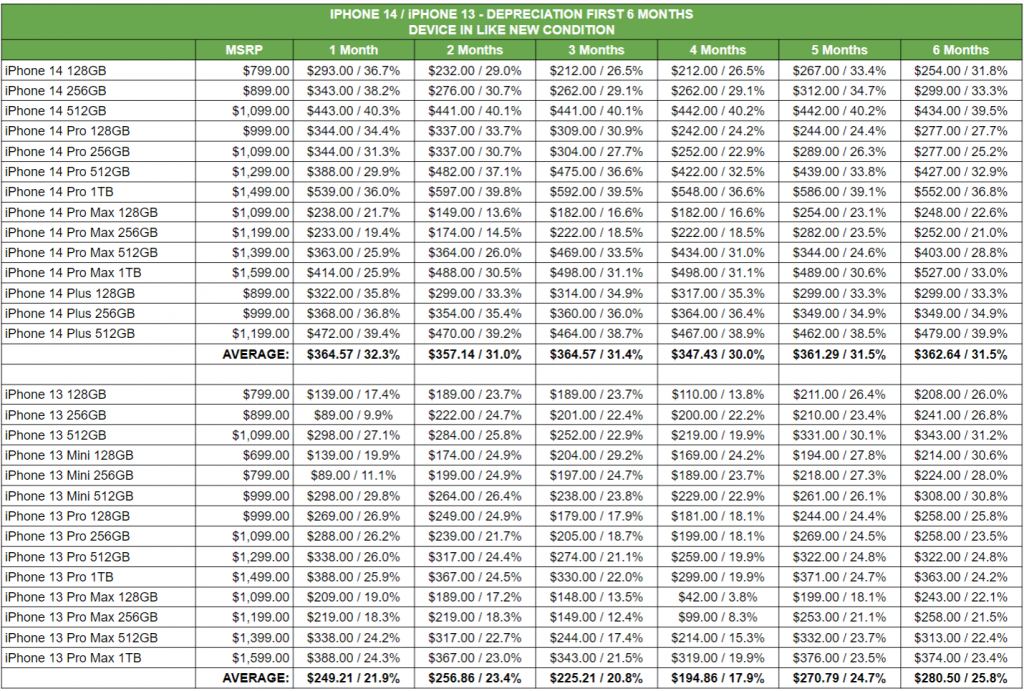
As the above table illustrates, the iPhone 14 is performing well, losing on average 31.5% over the past six months when it was launched. A number of models have actually recuperated some value, which we saw last year with the iPhone 13.
However, by the six-month mark, the iPhone 13 series of smartphones had only lost 25.8% of its value on average, across the entire range of iPhone 13 handsets. So, the iPhone 14 is still not performing as well as the iPhone 13 range did, which SellCell predicted would be the case in its iPhone 14 vs iPhone 13 depreciation report.
iPhone Remains the Most Valuable Handset
Despite the Samsung Galaxy S23 catching up a touch, it still hasn’t managed to outdo the iPhone 14. Neither has Google’s efforts with the Pixel 7. Even so, we have seen how the iPhone 14 range has not lived up to the performance of the iPhone 13, losing 5.7% more of its MSRP within six month. However, with Samsung closing the gap, could we see a turn in fortune when the brand launches its next generation of smartphones?
That remains for us to see, but for now the iPhone retains its crown as the handset that holds its value better than any other.
Methodology
SellCell analysed internal sales data for iPhone 14, Samsung Galaxy S23, and Google Pixel 7 smartphone ranges, considering the trade-in value of all models from each respective range, in “good” and “like new” condition, to determine the value depreciation of the handsets in months 1 and 2 since launch. It also compared this data to that for the Samsung Galaxy S22, Google Pixel 6, and iPhone 13, to see whether any patterns existed.
